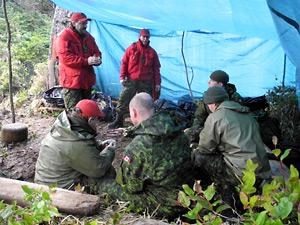A Powell River woman recently spent a week teaching survival skills to members of the Canadian Forces on Haida Gwaii.
For Jeannie Keays, survival training is something she has been interested in her whole life. Keays is a mother, seasonal worker and member of Powell River Canadian Rangers Patrol. The Canadian Rangers are a subcomponent of the Canadian Forces reserve. They provide a military presence in northern, coastal and isolated Canada and members are easily recognized by their red hats and shirts.
Keays joined Canadian Rangers from across the province teaching fire building, traps and snares, shelters and other survival skills to members of 39 Brigade over a three-day period. The soldiers then spent three days in survival camps with limited resources, putting those skills to the test.
Basic Wilderness Survival Training is offered by the Canadian Rangers once a year to other branches of the Canadian Forces, said Captain Steven Parker, BC detachment commander for the Fourth Canadian Rangers Patrol Group. He added that Canadian Rangers are used to teaching the training because of their vast amount of outdoor skills.
Keays taught fire-starting at the training, using magnesium and flint. The experience was amazing, she said, but different terrain proved to be more of a challenge than she expected. “When I first heard I was going to Haida Gwaii I was excited. I thought, ‘this is my area, this is the West Coast, this is what I know.’ When I got there I realized, ‘this is not like Powell River.’” She said it was hard to have to demonstrate fire-starting with spruce and hemlock. “The pressure of having to perform in front of people, added to having to use unfamiliar woods, was challenging.”
Keays has participated in survival training in Mackenzie, BC, and she said the difference between cold-weather survival and wet-weather survival was significant. “How do you build a shelter here when you have to deal with rain, as opposed to how do you build a shelter when you have to deal with snow? I think for everybody, it was a bit more challenging.”
Parker chose Haida Gwaii for the training because of the wet coastal conditions. “I chose it specifically to change the element of risk, to mix it up a bit…the danger of hypothermia is actually greater in a wet and temperate climate than in a cold and dry one.”
Four of the 22 soldiers didn’t last the three days in the wilderness, although all of them were able to light a fire by evening on the first day. Keays thinks the soldiers learned a lot and were glad they did it. “I think the people who had to come in were feeling sorry for themselves, but other than that it was good.” She said she hopes to teach survival again in the future, as she enjoys the challenge of instructing and really enjoys the teamwork.



